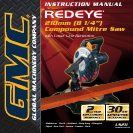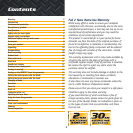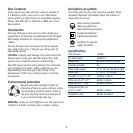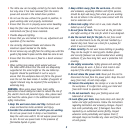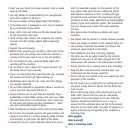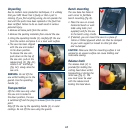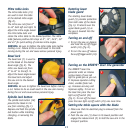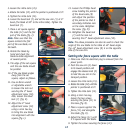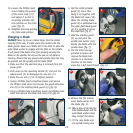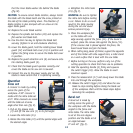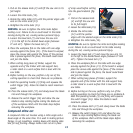7
• Never use your hands to remove sawdust, chips or waste
close by the blade.
• Use only blades as recommended by the manufacturer
and which conform to EN 847-1.
• Do not use blades of High Speed Steel (HSS blades).
• If the table insert is damaged or worn, have it replaced
by an authorised service centre.
• Rags, cloths, cord and string and the like should never
be left around the work area.
• Avoid cutting nails. Inspect the workpiece and remove
all nails and other foreign objects before beginning
sawing.
• Support the work properly.
• Refrain from removing any cut-offs or other parts of the
workpiece from the cutting area whilst the machine is
running and the saw head is not in the rest position.
• Do not attempt to free a jammed blade before first
switching off the machine.
• Do not slow or stop a blade with a piece of wood. Let
the blade come to rest naturally.
• If you are interrupted when operating the saw, complete
the process and switch off before looking up.
• Periodically check that all nuts, bolts and other fixings
are properly tightened.
• Do not store materials or equipment above a machine in
such a way that they could fall into it.
• Always hold the saw on parts that are insulated. If you
accidentally cut into hidden wiring or the saw’s own cable,
the metal parts of the saw will become “live”. Switch off
at the mains and remove the plug immediately.
• Never
saw near combustible liquids or gases.
• Note the direction of rotation of the motor and the blade.
• Do not lock the movable guard in the open position and
always ensure that it is working properly, freely rotating
and returning to fully cover the teeth of the blade.
• Connect the saw to a dust collection devise and ensure
that it is operated properly. As the operator of the
saw, please make sure that you understand factors
that influence exposure to dust, including the type
of material to be machined, the importance of local
extraction and the proper adjustment of hoods/baffles/
shoots of your dust extraction system. We recommend
that you always wear a dust mask when operating
this saw.
• Wear gloves when handling saw blades and rough
materials.
• Saw blades shall be carried in a holder wherever possible.
• Select saw blades in relation to the material being cut.
• Use correctly sharpened saw blades and observe the
maximum speed marked on the blade.
• Take additional care when trenching (slotting).
• The mitre saw can be safely carried by the carrying
handle but only once it has been removed from the
mains power and secured in the locked down position.
• Ensure that the arm is properly secure when bevelling.
• Keep the floor area around the machine level, well
maintained and free of loose materials.
• Ensure that you are trained in the use, adjustment and
operation of the machine.
• Do not remove any cut-offs from the cutting area until
the guard is fully locked in placed and the blade has
come to rest.
• When cutting long pieces which extend well over the
table width, ensure that the ends are adequately
supported at the same height as the saw table top.
Supports should be positioned in such a way to
ensure that the workpiece does not fall to the ground
once the cut has been made. A number of supports at
regular intervals may be required if the workpiece is
extremely long.
Wear goggles
Wear earmuffs
Wear a breathing mask



